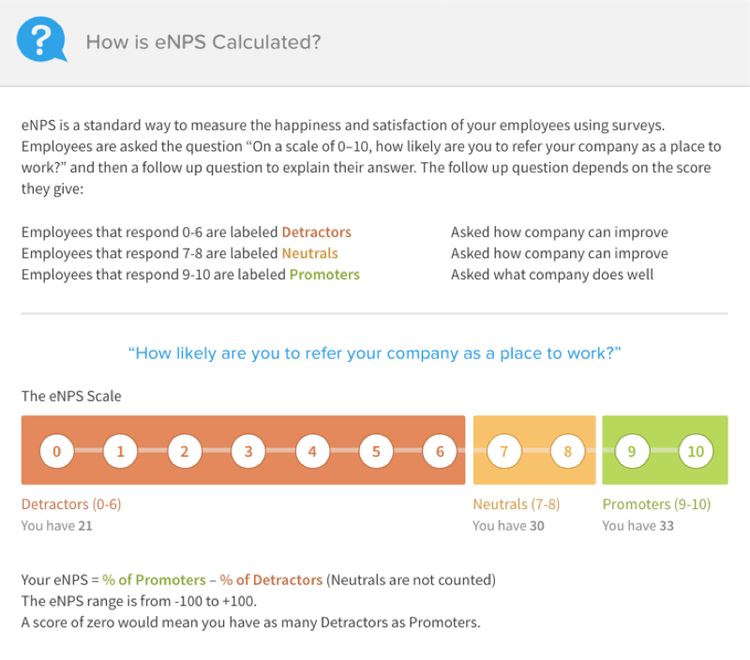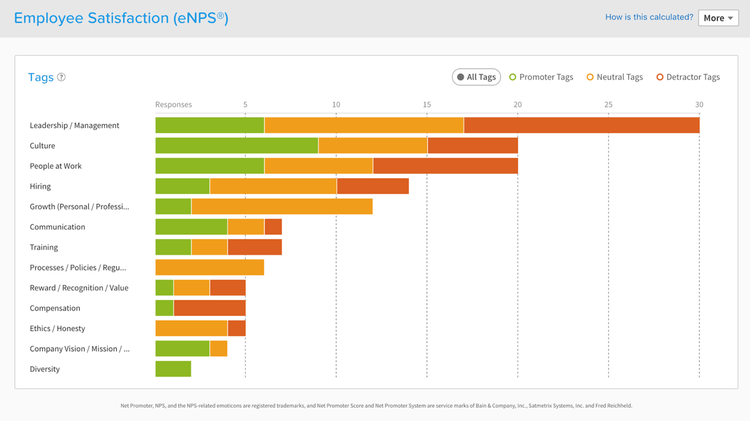How to Gain Key Employee Insights with eNPS and Employee Satisfaction Surveys

Employee satisfaction is a term used to describe how happy employees are with their job, and it has a direct effect on productivity and quality. It’s hard to really gauge how satisfied employees are without regular, consistent, and anonymous feedback, but the need to uncover these insights is pressing. According to Gallup’s 2022 State of the Global Workplace report, dissatisfaction at work is at an all-time high with 69% of people feeling emotionally detached and 19% saying they’re miserable.
How are your employees feeling? You can take a wild guess, or you can start collecting actionable data by calculating an employee Net Promoter Score (eNPS) based on responses to an employee satisfaction survey you set up yourself or manage with tried-and-true HR software.
What Is an Employee Net Promoter Score (eNPS)?
An employee Net Promoter Score (eNPS) was created by a researcher from Bain & Company who wanted to ease the time and cost burden of lengthy traditional satisfaction surveys. Not only is an eNPS survey easy for employees to complete, but the score is easy for leaders to interpret. Measuring eNPS requires your employees to answer just one question: On a scale of zero to ten, how likely are you to recommend [your company] as a place to work?
How Is eNPS Calculated?
Employees respond to an eNPS question with a number between zero and ten, zero being the least positive and ten being the most positive. Those who respond with a nine or ten are considered promoters, seven or eight are neutral, and zero through six are detractors.
To find your company’s eNPS, you subtract the percentage of detractors from the percentage of promoters to get a score somewhere between -100 and 100. Anything above zero is considered positive, so 10 would be a nice result! You should feel great if your score is between 10 and 30 and fantastic if your score is above 40.
For example, if you have 100 employees and 40 are promoters, 20 neutrals, and 30 detractors, you take 40% – 30% = 10. This would mean that you have an eNPS of 10.
Based on the scores they submit, your employees will fall into one of three categories:
- Promoters (9-10): Your promoter employees are one of your organization’s strongest assets. They can give valuable insights on what is going right at your company and can be a great resource for recruiting new employees as brand ambassadors. Those in leadership positions are more likely to be promoters than employees in any other position. Employees who have either just started with the company or are veteran employees are also the most likely to be promoters.
- Neutral (7-8): They may not be privately or publicly bad-mouthing your organization, but they aren’t talking it up either or recommending job openings to their friends. Neutral employees are not included in your final eNPS score, but their feedback still matters. These are employees that you have the best chance of turning into promoters.
- Detractors (6 or below): Unfortunately, a score this low means your employee is probably not satisfied with their job and is at risk of leaving the company or, even worse, sticking around and bringing down morale for everyone around them. But that doesn’t mean you should give detractors the boot. Listen to your detractors. They probably have some great ideas on how you can improve your organization.

How Often Should You Measure eNPS?
To strike a healthy balance, try for at least twice a year or once every quarter.
You have to find the right balance for how often to poll employees. Ask too often and your employees will be fatigued, less willing to participate, and less willing to provide additional feedback. But if you ask too infrequently, you won’t get the data you need to make real improvements.
Don’t feel like you failed if you don’t get a 100% completion rate. Organizations with the highest participation rates also generally have higher eNPS scores, so low participation rates are also a data point to include in your strategizing. However, a tool like BambooHR Employee Satisfaction with eNPS automates the survey send, plus reminders, to ensure you’re getting as much data as possible.

An eNPS Score is a Great Start, But There’s More to Learn
An eNPS score is a great start to measuring employee satisfaction, and it provides a broad picture for your organization. But you may have to do some more digging to get all the information you need. Company updates, regular one-on-ones with managers, performance reviews, and adding open-ended feedback questions to an eNPS survey can help you dive into smaller-scale growth areas at your company.
Employees want to be heard. Is your organization listening?
With accurate, reliable employee surveys in BambooHR, you'll gain the insight you need to prevent burnout, improve morale, and stop premature turnover in its tracks.
What Is an Employee Satisfaction Survey?
An employee satisfaction survey is a more freeform take on measuring how happy your employees are with their job and your organization. You get to decide how long the survey is, how it’s structured, and what you ask. While this can allow room for more specific questions, it does take more time to put together and analyze, and won’t give you the clear-cut number of an eNPS. You’ll work hard for the data, but you’ll end up with a lot of information if you do things right.
How to Write Employee Satisfaction Survey Questions
When writing an employee satisfaction survey, you want to make your survey long enough that you get the data you need, but not so long that you take employees away from their work for an extended time, or bore them so much that they quit the survey before finishing.
Keep your questions clear and easy to understand, but specific. As you are writing your questions, follow these tips from Qualtrics:
- Be simple, direct, comprehensible
- Be actionable
- Be specific and concrete
- Avoid jargon
- Avoid double-barreled questions
- Avoid negations
- Avoid leading questions
- Avoid emotionally charged words
- Allow for all possible responses
Your data will be most valuable if you can compare it from one survey to the next so try to write questions that you can ask in repeated surveys. Keeping language consistent from time-to-time and year-to-year allows you to measure and compare changes. Try focusing on some of the following topics in your surveys:
- Inclusion and belonging
- Engagement
- Company culture
- Compensation
- Financial benefits
- Personal goals
- Health benefits
- Manager performance
- Career development
- Work environment
- Team performance
If you choose to create your own employee satisfaction survey, expect to spend quite a bit of time and resources on it. If it’s done right, you’ll get some great data that can help you propel your company forward.
» Learn More: 15 Employee Engagement Survey Questions
3 Key Benefits of Measuring Employee Satisfaction
1. Getting Employee Feedback
Feedback from your employees will reveal crucial areas for improvement. Employees generally have a lot to say. A lot more than you might realize. And they deserve the chance to give their honest feedback. A walk through the office can’t give you the kind of data a survey or report can.
2. Reduced Turnover
A ping pong table won’t be enough to keep your best employees if they don’t feel valued and content with their job. Finding out what really matters to your teams so you can remove roadblocks and create a positive working environment will help keep your employees around for the long haul.
3. Increased Productivity
Unhappy employees don’t have a great reputation for staying productive at work. Those unhappy workers cost the global market $7.8 trillion in lost productivity in 2022. Measuring employee satisfaction can give you the data you need to target initiatives for boosting your workforce productivity and for measuring the effectiveness of those initiatives over time.
Now that you know why measuring employee satisfaction will be beneficial, the bigger question is “How do I measure employee satisfaction?”
How to Measure (and Improve) Employee Satisfaction
Once you've gathered employee satisfaction data, start with comparing data between surveys. Focus on how you are watching employee satisfaction at your organization change.
For example:
- Did your eNPS rise after you introduced a new benefits package?
- Did your survey results come back more negative after you implemented a new time-tracking policy?
When you notice trends in results and in the feedback your employees are offering, you can create an action plan. What exactly you need to do will largely depend on what kind of responses you get back, but these are some common actionable items that can improve employee satisfaction scores.
Offer a Post-Survey Debrief
- Be Transparent. You should be transparent about what the results of your survey are. When employees know they are being heard, they are more likely to continue sharing, and maybe even share more during your next round of employee satisfaction surveys.
- Practice Accountability. You can use your eNPS or survey results to assess how well the choices, benefits, and culture you are offering your employees are aligned with your values. If your employees’ experiences reflect a company culture that is not in line with your values, you can better pinpoint when you’re missing the mark.
Look for Ways to Boost Productivity
- Become More Flexible with Schedules. If employees are unsatisfied with their work schedule, consider becoming more flexible. If it isn’t imperative that they come in at a specific time, give them more leeway on when they can come and go. Employees have a life outside of their 9-to-5 jobs, and sometimes that life overlaps with their work schedule. Allowing them to be flexible in their time can relieve a lot of stress and even increase their productivity.
- Cut Out Time Wasters. If employees feel like they waste a lot of time at work, it may be time to reorganize and streamline different processes. Cancel meetings if they no longer seem productive or valuable, and assess your employees’ workload to see if any busywork can be cut back. Chances are plenty of inefficiencies have crept their way into your company, so take the opportunity to weed them out and make everyone’s life a little easier.
Improve Performance Management
- Stop Micromanaging. Managers who insist on controlling everything their employees do can have a negative impact on work culture. Encourage managers to delegate responsibility more often and allow employees to find their own solutions to challenges. Trusting employees to do their jobs (and do them well) will foster more respect and satisfaction in the workplace for everyone.
- Create a Feedback Loop. Keep in mind as you assess results that you don’t have to respond to every single employee complaint or suggestion, but you do need to make it clear to your employees that you hear them. The easiest way to implement a strong feedback loop in your company is regular employee/manager one-on-ones. Over 90% of employees who receive positive recognition on a daily basis say they are satisfied or very satisfied with their company. Employees need a space to talk about their goals and challenges and to receive coaching from managers. One-on-ones don’t have to feel like a quick rush through an agenda; take your time and really enjoy the space to discuss how things are going.
- Offer Complete Reviews. Performance and 360-degree feedback reviews give you opportunities to reflect on individual performance and get formal feedback from peers and managers. Such complete, formal reviews have two major benefits. Firstly, not every manager is quick to dole out praise and suggestions for improvement. It’s just not everyone’s style. But that doesn’t mean employees don’t need that feedback. Formal reviews make sure everyone at the company is getting the feedback they need. Secondly, quiet, reflective feedback can come out differently than off-the-cuff comments and suggestions that may come up in one-on-one meetings and during projects. Pausing to reflect on your own performance or the performance of one of your employees may yield some valuable insights.
Offer New Growth Opportunities
- Set Up Job Training and Other Education Opportunities. Employees never want to feel like they’ve hit a dead-end in their career. To prevent this, consider offering job training and other opportunities that help expand employees’ job horizons. As employees expand their skill sets and learn about new job possibilities, they’ll see a path forward in their careers instead of a brick wall. Plus, it shows that you value your employees beyond what they do for your company right now as you’re investing in their career development.
*Net Promoter, NPS, and the NPS-related emoticons are registered U.S. trademarks, and NetPromoter Score and Net Promoter System are service marks, of Bain & Company, Inc., NICE Systems, Inc. and Fred Reichheld.